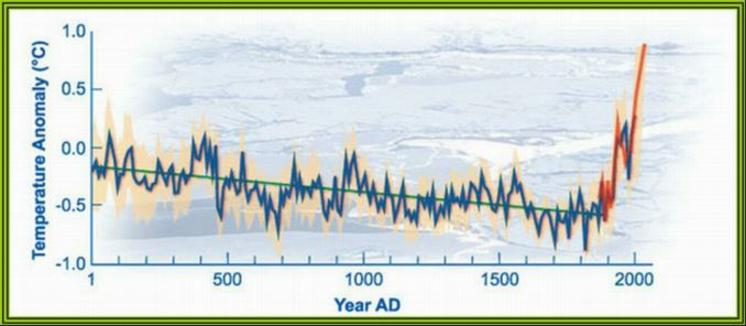From Time - Contributed by Lon Frank
Glaciers are thought to change at, well, a glacial pace. Certainly that has been true throughout the planet's history. The current ice age — known as the Pilocene-Quatenary glaciation, which began 2.6 million years ago — has witnessed some 20 cycles of glacial (freezing) and interglacial (thawing) periods, with ice sheets advancing and retreating completely on roughly 100,000-year time scales. But scientists are unsure exactly what prompts the shifts in cycles.
In glacial periods, vast ice sheets cover much of the planet, and sea levels are as much as 130 meters lower than they are today (all that extra water is locked up in ice). During interglacial periods — we are enjoying one now, East Coast blizzards notwithstanding — the ice sheets retreat, the glaciers melt and sea level rises. The expansive but quickly melting ice sheets of Greenland, the North Pole and Antarctica are all that is left of our last glacial period, which reached its peak about 20,000 years ago.
Now a new study published in the Feb. 12 issue of Science indicates that the balance of the world's ice may be shifting faster than scientists thought, which may have consequences in a warming world. A team of scientists traveled to the Spanish island of Mallorca, where they visited a coastal cave that has been submerged off and on by the Mediterranean Sea for hundreds of thousand of years, as glacial periods have waxed and waned. They dated the layers of the mineral calcite, which were deposited by the seawater in rings on the cave walls, as on a bathtub.
Scientists were then able to infer the approximate sea level at the time the calcite was deposited, and estimate that some 81,000 years ago sea levels were about 1 m higher than they are now — which suggests that global temperatures were at least as high, or higher than they are now, even though CO2 concentrations in the atmosphere were much lower then. The study also indicates that the sea level was changing rapidly around this time period, rising as much as 1 m the century before, as ice melted, and then falling afterward at around the same speed, as ice began to freeze once more. Rather than forming steadily and melting steadily, the process of glacier freezing and receding may be more more unstable, reflected in sudden rising and falling of the sea level. "It's fair to say that this means glaciers may change somewhat faster than we once inferred," says Jeffrey Dorale, a geoscientist at the University of Iowa and the lead author of the Science paper. "It does suggest there can be very fast is melting and very fast ice building at times when CO2 levels were lower than now."
One reason that sea levels may have been higher 81,000 years ago than today is that the Earth was receiving stronger solar radiation at that time. That would fit into what's known as the Milankovitch theory of ice-age cycles, which posits that the Earth's orbit around the sun and the planet's axial tilt wobble periodically, increasing or decreasing the amount of solar radiation hitting the planet's surface. "The sea-level high may be considered an exception to the 100,000-year cycle, in which high summer sunlight caused the ice sheets to melt," writes R. Lawrence Edwards, a geologist at the University of Minnesota, in a commentary on the Science paper.
Of course, Dorale's sea-level measurements are just one point of data that will need to be confirmed by other scientists — along with his own work, which will continue in Mallorca. And because the Earth itself changes shape over tens of thousands of years, responding to the shift of ice and water on its surface, it's impossible to infer the entire geological story from one location at one point of time.
But one of the biggest gaps in climate science is our understanding of how the major ice sheets of Greenland and Antarctica will respond to warming temperatures. The science is so foggy that the Intergovernmental Panel on Climate Change — which recently came under attack for hyping the impacts of global warming — has refrained from estimating how fast those ice sheets could melt and contribute to sea level rise. Dorale's paper suggests the possibility that ice sheets may respond much more dynamically to changes in temperature, forming and melting at rates that are quicker than previously thought. "There might be a feedback with regards to ice melting," says Dorale. "This is speculation, but it might point at some sort of catastrophic ice sheet dynamic."
In other words, it could mean the world's seas will rise even more quickly than we expect — bad news for those who think there's plenty of time to adapt to a warmer world.
Read The Original Article
Welcome to By 2100!
This Blog is designed to be a Diary of Events illustrating Global Climate Change, and where it will lead.
Commentary is encouraged, but this Blog is not intended for discussion on the Validity of Climate Change.
Category Labels
- Climate Events (85)
- Climate Solutions (45)
- Videos (42)
- Climate Statistics (39)
- The Deniers (34)
- Humour (15)
- Basic Information (5)
Friday, February 12, 2010
Subscribe to:
Post Comments (Atom)
www.know-the-number.com
Our Climate is Changing!Please download Flash Player.

No comments:
Post a Comment